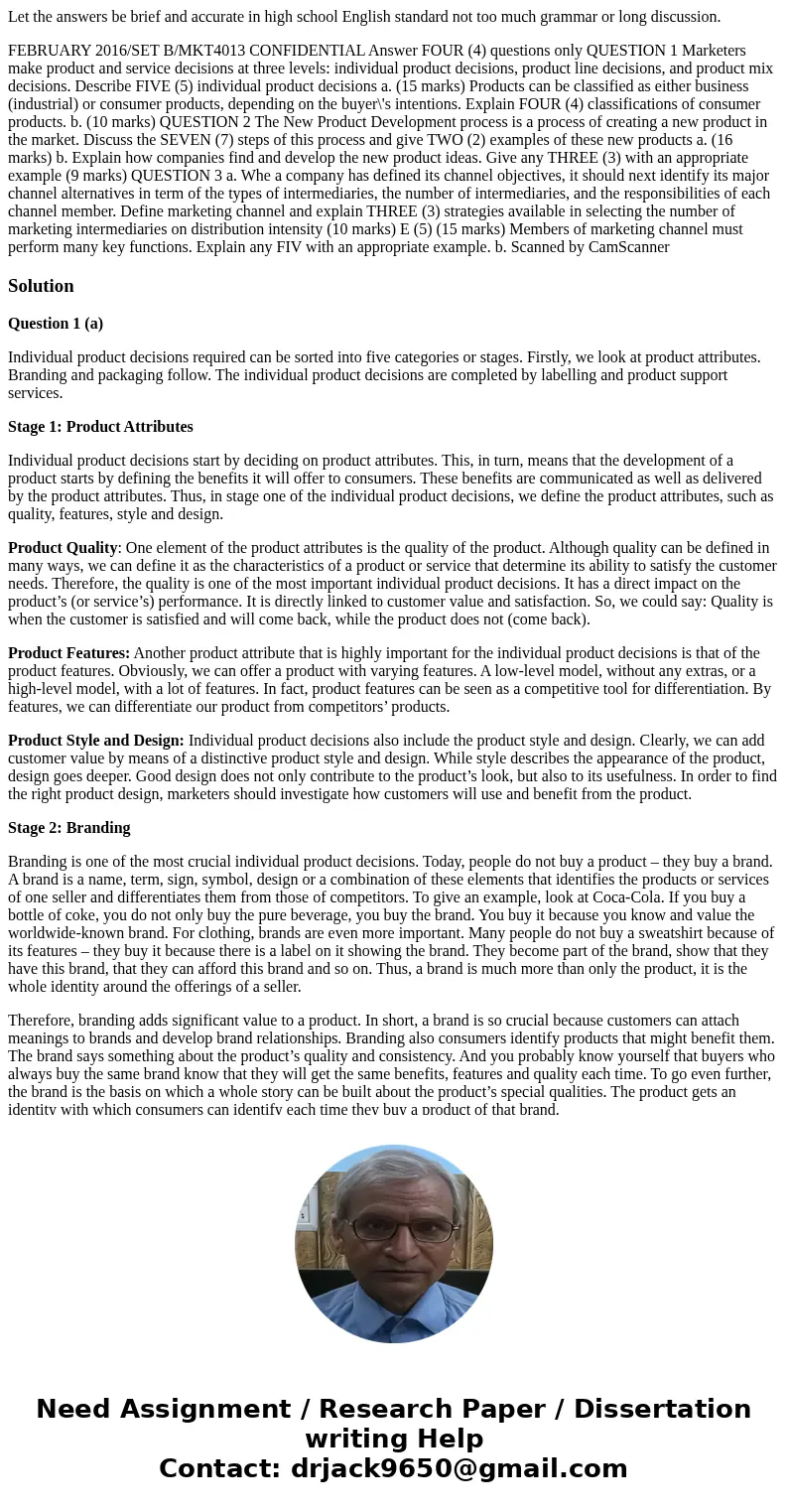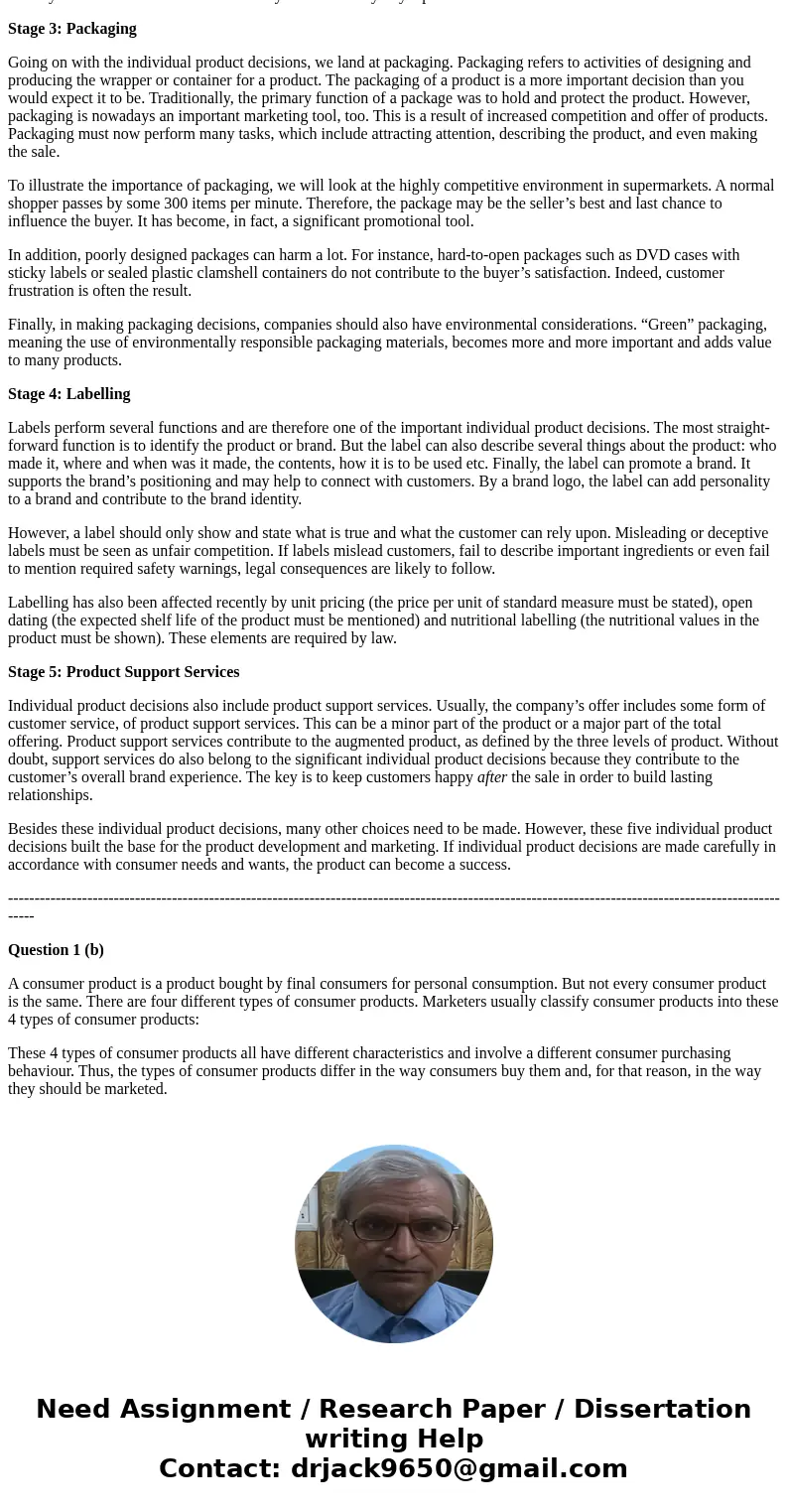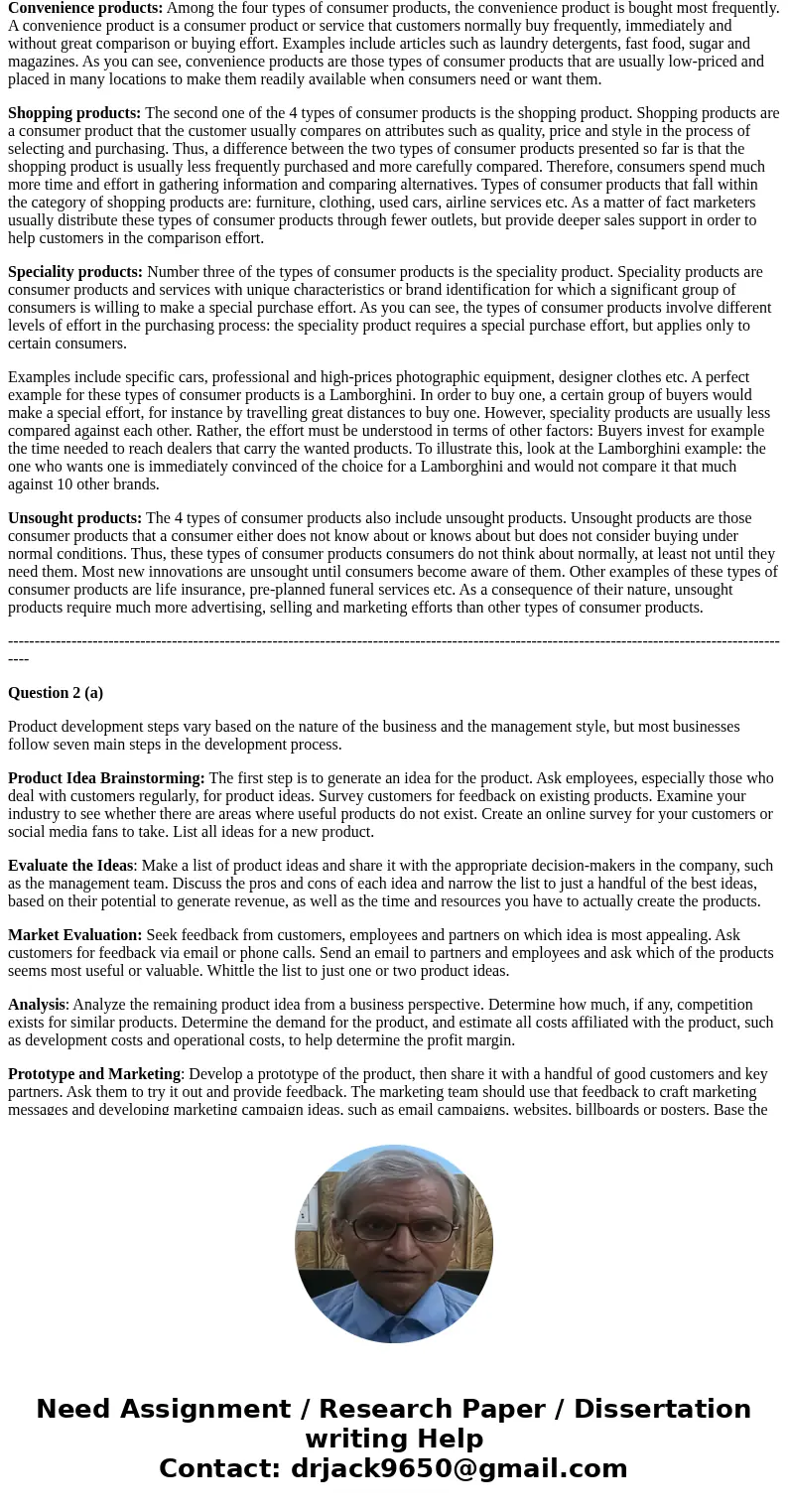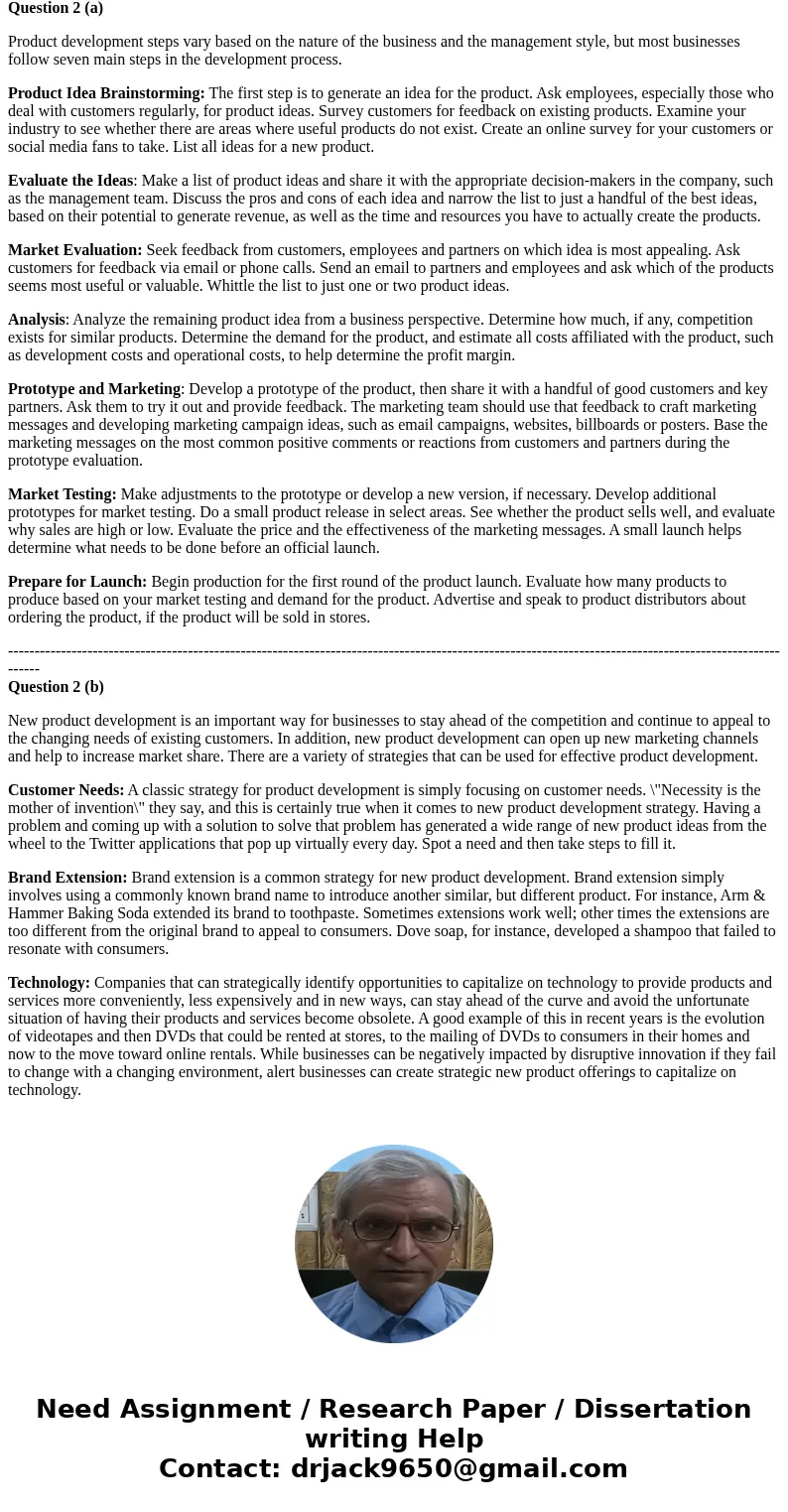Let the answers be brief and accurate in high school English
Let the answers be brief and accurate in high school English standard not too much grammar or long discussion.
FEBRUARY 2016/SET B/MKT4013 CONFIDENTIAL Answer FOUR (4) questions only QUESTION 1 Marketers make product and service decisions at three levels: individual product decisions, product line decisions, and product mix decisions. Describe FIVE (5) individual product decisions a. (15 marks) Products can be classified as either business (industrial) or consumer products, depending on the buyer\'s intentions. Explain FOUR (4) classifications of consumer products. b. (10 marks) QUESTION 2 The New Product Development process is a process of creating a new product in the market. Discuss the SEVEN (7) steps of this process and give TWO (2) examples of these new products a. (16 marks) b. Explain how companies find and develop the new product ideas. Give any THREE (3) with an appropriate example (9 marks) QUESTION 3 a. Whe a company has defined its channel objectives, it should next identify its major channel alternatives in term of the types of intermediaries, the number of intermediaries, and the responsibilities of each channel member. Define marketing channel and explain THREE (3) strategies available in selecting the number of marketing intermediaries on distribution intensity (10 marks) E (5) (15 marks) Members of marketing channel must perform many key functions. Explain any FIV with an appropriate example. b. Scanned by CamScannerSolution
Question 1 (a)
Individual product decisions required can be sorted into five categories or stages. Firstly, we look at product attributes. Branding and packaging follow. The individual product decisions are completed by labelling and product support services.
Stage 1: Product Attributes
Individual product decisions start by deciding on product attributes. This, in turn, means that the development of a product starts by defining the benefits it will offer to consumers. These benefits are communicated as well as delivered by the product attributes. Thus, in stage one of the individual product decisions, we define the product attributes, such as quality, features, style and design.
Product Quality: One element of the product attributes is the quality of the product. Although quality can be defined in many ways, we can define it as the characteristics of a product or service that determine its ability to satisfy the customer needs. Therefore, the quality is one of the most important individual product decisions. It has a direct impact on the product’s (or service’s) performance. It is directly linked to customer value and satisfaction. So, we could say: Quality is when the customer is satisfied and will come back, while the product does not (come back).
Product Features: Another product attribute that is highly important for the individual product decisions is that of the product features. Obviously, we can offer a product with varying features. A low-level model, without any extras, or a high-level model, with a lot of features. In fact, product features can be seen as a competitive tool for differentiation. By features, we can differentiate our product from competitors’ products.
Product Style and Design: Individual product decisions also include the product style and design. Clearly, we can add customer value by means of a distinctive product style and design. While style describes the appearance of the product, design goes deeper. Good design does not only contribute to the product’s look, but also to its usefulness. In order to find the right product design, marketers should investigate how customers will use and benefit from the product.
Stage 2: Branding
Branding is one of the most crucial individual product decisions. Today, people do not buy a product – they buy a brand. A brand is a name, term, sign, symbol, design or a combination of these elements that identifies the products or services of one seller and differentiates them from those of competitors. To give an example, look at Coca-Cola. If you buy a bottle of coke, you do not only buy the pure beverage, you buy the brand. You buy it because you know and value the worldwide-known brand. For clothing, brands are even more important. Many people do not buy a sweatshirt because of its features – they buy it because there is a label on it showing the brand. They become part of the brand, show that they have this brand, that they can afford this brand and so on. Thus, a brand is much more than only the product, it is the whole identity around the offerings of a seller.
Therefore, branding adds significant value to a product. In short, a brand is so crucial because customers can attach meanings to brands and develop brand relationships. Branding also consumers identify products that might benefit them. The brand says something about the product’s quality and consistency. And you probably know yourself that buyers who always buy the same brand know that they will get the same benefits, features and quality each time. To go even further, the brand is the basis on which a whole story can be built about the product’s special qualities. The product gets an identity with which consumers can identify each time they buy a product of that brand.
Stage 3: Packaging
Going on with the individual product decisions, we land at packaging. Packaging refers to activities of designing and producing the wrapper or container for a product. The packaging of a product is a more important decision than you would expect it to be. Traditionally, the primary function of a package was to hold and protect the product. However, packaging is nowadays an important marketing tool, too. This is a result of increased competition and offer of products. Packaging must now perform many tasks, which include attracting attention, describing the product, and even making the sale.
To illustrate the importance of packaging, we will look at the highly competitive environment in supermarkets. A normal shopper passes by some 300 items per minute. Therefore, the package may be the seller’s best and last chance to influence the buyer. It has become, in fact, a significant promotional tool.
In addition, poorly designed packages can harm a lot. For instance, hard-to-open packages such as DVD cases with sticky labels or sealed plastic clamshell containers do not contribute to the buyer’s satisfaction. Indeed, customer frustration is often the result.
Finally, in making packaging decisions, companies should also have environmental considerations. “Green” packaging, meaning the use of environmentally responsible packaging materials, becomes more and more important and adds value to many products.
Stage 4: Labelling
Labels perform several functions and are therefore one of the important individual product decisions. The most straight-forward function is to identify the product or brand. But the label can also describe several things about the product: who made it, where and when was it made, the contents, how it is to be used etc. Finally, the label can promote a brand. It supports the brand’s positioning and may help to connect with customers. By a brand logo, the label can add personality to a brand and contribute to the brand identity.
However, a label should only show and state what is true and what the customer can rely upon. Misleading or deceptive labels must be seen as unfair competition. If labels mislead customers, fail to describe important ingredients or even fail to mention required safety warnings, legal consequences are likely to follow.
Labelling has also been affected recently by unit pricing (the price per unit of standard measure must be stated), open dating (the expected shelf life of the product must be mentioned) and nutritional labelling (the nutritional values in the product must be shown). These elements are required by law.
Stage 5: Product Support Services
Individual product decisions also include product support services. Usually, the company’s offer includes some form of customer service, of product support services. This can be a minor part of the product or a major part of the total offering. Product support services contribute to the augmented product, as defined by the three levels of product. Without doubt, support services do also belong to the significant individual product decisions because they contribute to the customer’s overall brand experience. The key is to keep customers happy after the sale in order to build lasting relationships.
Besides these individual product decisions, many other choices need to be made. However, these five individual product decisions built the base for the product development and marketing. If individual product decisions are made carefully in accordance with consumer needs and wants, the product can become a success.
-------------------------------------------------------------------------------------------------------------------------------------------------------
Question 1 (b)
A consumer product is a product bought by final consumers for personal consumption. But not every consumer product is the same. There are four different types of consumer products. Marketers usually classify consumer products into these 4 types of consumer products:
These 4 types of consumer products all have different characteristics and involve a different consumer purchasing behaviour. Thus, the types of consumer products differ in the way consumers buy them and, for that reason, in the way they should be marketed.
Convenience products: Among the four types of consumer products, the convenience product is bought most frequently. A convenience product is a consumer product or service that customers normally buy frequently, immediately and without great comparison or buying effort. Examples include articles such as laundry detergents, fast food, sugar and magazines. As you can see, convenience products are those types of consumer products that are usually low-priced and placed in many locations to make them readily available when consumers need or want them.
Shopping products: The second one of the 4 types of consumer products is the shopping product. Shopping products are a consumer product that the customer usually compares on attributes such as quality, price and style in the process of selecting and purchasing. Thus, a difference between the two types of consumer products presented so far is that the shopping product is usually less frequently purchased and more carefully compared. Therefore, consumers spend much more time and effort in gathering information and comparing alternatives. Types of consumer products that fall within the category of shopping products are: furniture, clothing, used cars, airline services etc. As a matter of fact marketers usually distribute these types of consumer products through fewer outlets, but provide deeper sales support in order to help customers in the comparison effort.
Speciality products: Number three of the types of consumer products is the speciality product. Speciality products are consumer products and services with unique characteristics or brand identification for which a significant group of consumers is willing to make a special purchase effort. As you can see, the types of consumer products involve different levels of effort in the purchasing process: the speciality product requires a special purchase effort, but applies only to certain consumers.
Examples include specific cars, professional and high-prices photographic equipment, designer clothes etc. A perfect example for these types of consumer products is a Lamborghini. In order to buy one, a certain group of buyers would make a special effort, for instance by travelling great distances to buy one. However, speciality products are usually less compared against each other. Rather, the effort must be understood in terms of other factors: Buyers invest for example the time needed to reach dealers that carry the wanted products. To illustrate this, look at the Lamborghini example: the one who wants one is immediately convinced of the choice for a Lamborghini and would not compare it that much against 10 other brands.
Unsought products: The 4 types of consumer products also include unsought products. Unsought products are those consumer products that a consumer either does not know about or knows about but does not consider buying under normal conditions. Thus, these types of consumer products consumers do not think about normally, at least not until they need them. Most new innovations are unsought until consumers become aware of them. Other examples of these types of consumer products are life insurance, pre-planned funeral services etc. As a consequence of their nature, unsought products require much more advertising, selling and marketing efforts than other types of consumer products.
------------------------------------------------------------------------------------------------------------------------------------------------------
Question 2 (a)
Product development steps vary based on the nature of the business and the management style, but most businesses follow seven main steps in the development process.
Product Idea Brainstorming: The first step is to generate an idea for the product. Ask employees, especially those who deal with customers regularly, for product ideas. Survey customers for feedback on existing products. Examine your industry to see whether there are areas where useful products do not exist. Create an online survey for your customers or social media fans to take. List all ideas for a new product.
Evaluate the Ideas: Make a list of product ideas and share it with the appropriate decision-makers in the company, such as the management team. Discuss the pros and cons of each idea and narrow the list to just a handful of the best ideas, based on their potential to generate revenue, as well as the time and resources you have to actually create the products.
Market Evaluation: Seek feedback from customers, employees and partners on which idea is most appealing. Ask customers for feedback via email or phone calls. Send an email to partners and employees and ask which of the products seems most useful or valuable. Whittle the list to just one or two product ideas.
Analysis: Analyze the remaining product idea from a business perspective. Determine how much, if any, competition exists for similar products. Determine the demand for the product, and estimate all costs affiliated with the product, such as development costs and operational costs, to help determine the profit margin.
Prototype and Marketing: Develop a prototype of the product, then share it with a handful of good customers and key partners. Ask them to try it out and provide feedback. The marketing team should use that feedback to craft marketing messages and developing marketing campaign ideas, such as email campaigns, websites, billboards or posters. Base the marketing messages on the most common positive comments or reactions from customers and partners during the prototype evaluation.
Market Testing: Make adjustments to the prototype or develop a new version, if necessary. Develop additional prototypes for market testing. Do a small product release in select areas. See whether the product sells well, and evaluate why sales are high or low. Evaluate the price and the effectiveness of the marketing messages. A small launch helps determine what needs to be done before an official launch.
Prepare for Launch: Begin production for the first round of the product launch. Evaluate how many products to produce based on your market testing and demand for the product. Advertise and speak to product distributors about ordering the product, if the product will be sold in stores.
--------------------------------------------------------------------------------------------------------------------------------------------------------
Question 2 (b)
New product development is an important way for businesses to stay ahead of the competition and continue to appeal to the changing needs of existing customers. In addition, new product development can open up new marketing channels and help to increase market share. There are a variety of strategies that can be used for effective product development.
Customer Needs: A classic strategy for product development is simply focusing on customer needs. \"Necessity is the mother of invention\" they say, and this is certainly true when it comes to new product development strategy. Having a problem and coming up with a solution to solve that problem has generated a wide range of new product ideas from the wheel to the Twitter applications that pop up virtually every day. Spot a need and then take steps to fill it.
Brand Extension: Brand extension is a common strategy for new product development. Brand extension simply involves using a commonly known brand name to introduce another similar, but different product. For instance, Arm & Hammer Baking Soda extended its brand to toothpaste. Sometimes extensions work well; other times the extensions are too different from the original brand to appeal to consumers. Dove soap, for instance, developed a shampoo that failed to resonate with consumers.
Technology: Companies that can strategically identify opportunities to capitalize on technology to provide products and services more conveniently, less expensively and in new ways, can stay ahead of the curve and avoid the unfortunate situation of having their products and services become obsolete. A good example of this in recent years is the evolution of videotapes and then DVDs that could be rented at stores, to the mailing of DVDs to consumers in their homes and now to the move toward online rentals. While businesses can be negatively impacted by disruptive innovation if they fail to change with a changing environment, alert businesses can create strategic new product offerings to capitalize on technology.




 Homework Sourse
Homework Sourse